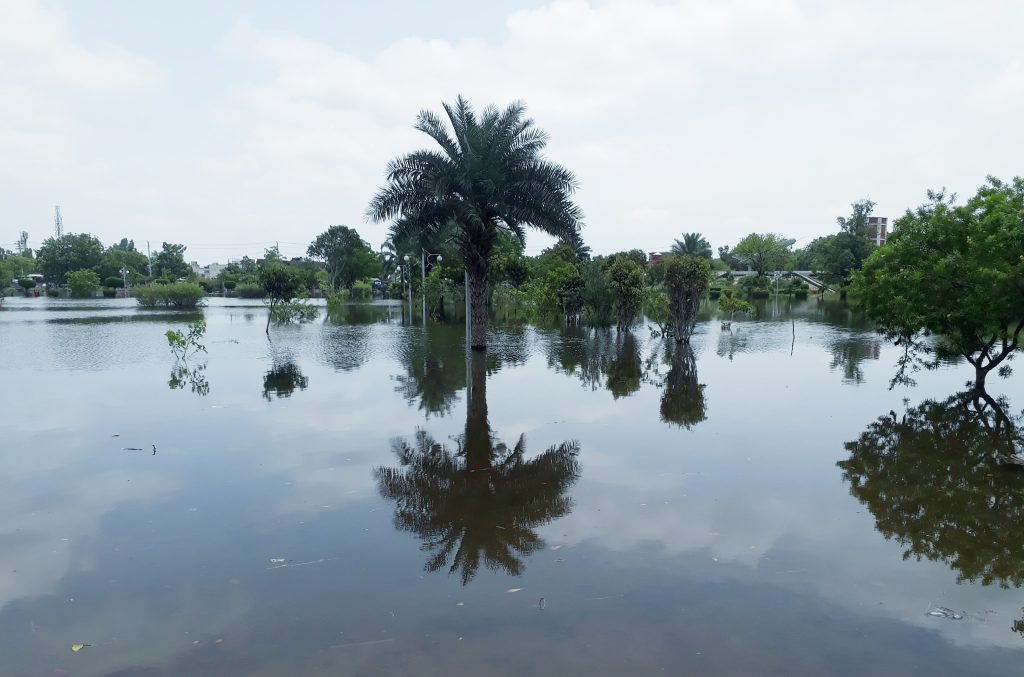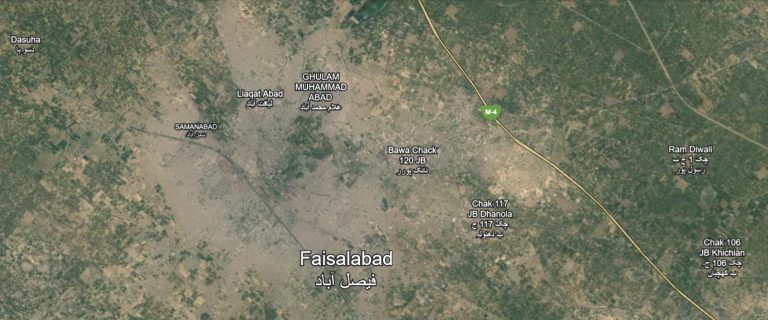Rainwater: A crises or an opportunity?
Rainwater conservation would not only mitigate the impact of increasingly intense rainfalls caused by climate change but also turn the challenge into an opportunity to create an eco-friendly and water-resilient Faisalabad.

On the morning of August 4, 30-year-old Manzoor Ahmed, a resident of Islamia Park, and his wife took their six-month-old son to Khadija Mahmood Trust Hospital for a routine check-up but they did not know that their day would take a dramatic turn.
Ahmed explained that their baby had developed a fever the previous night and was refusing to eat or drink, prompting them to seek medical advice. “We had just reached the hospital when the sky darkened, and a heavy downpour began,” he recalled.
Initially, Ahmed felt relieved, hoping the rain would bring some respite from the sweltering heat. However, as the rain persisted for over an hour, he, along with other patients, grew increasingly anxious. The situation inside the hospital became dire as rainwater began seeping into the building, and within the next two hour, water levels outside had risen to five or six feet.
“The hospital staff looked worried, and so were we,” Ahmed said. “It was terrifying to see the water rising so quickly.”
In a stroke of luck, a local aid organization managed to procure a boat, using it to evacuate patients from the flooded hospital. Reflecting on the ordeal, Ahmed described it as one of the scariest days of his life. “If it weren’t for the timely rescue, a major disaster could have occurred,” he concluded, visibly shaken by the experience.
On August 4, torrential rains wreaked havoc across the city, submerging not just the Khadija Memorial Trust Hospital but also flooding major roads, markets, and residential areas, with low-lying neighbourhoods being the hardest hit. According to a WASA spokesperson, the city received over 142 mm of rain that day, leading to severe drainage issues.
In response to the deluge, the city entered a state of emergency. Commissioner Salwat Saeed, Deputy Commissioner Abdullah Nair Sheikh, and MD WASA Aamir Aziz were on the ground late into the night, overseeing efforts to expedite the drainage of rainwater. To tackle the crisis, WASA deployed over 700 sewer workers, while hundreds of waste workers of Faisalabad Waste Management Company also joined the efforts to clear the waterlogged streets and neighbourhoods. The combined force worked tirelessly to restore normalcy to the city, but the scale of the flooding underscored the urgent need for better infrastructure and disaster preparedness.
The recent torrential rains are a stark reminder of the growing impact of climate change on urban life, with the increasing frequency and intensity of downpours significantly disrupting daily life in Faisalabad. This is not the first time the city has faced such challenges; in July 2021, a single day’s rainfall of 200 mm left most areas underwater for three to four days.
Faisalabad typically receives an annual average rainfall of 350 to 375 mm, with around half of that occurring during the monsoon season. However, this year’s monsoon has already brought approximately 550 mm of rain, with still over a month remaining in the season. According to MD WASA Amir Aziz, this year’s monsoon was predicted to bring 35% more rainfall than usual, and the current total is expected to double before the season ends.
Despite this, WASA’s sewage system is only capable of handling 33 to 35 mm of rainwater, meaning that heavier rains lead to significant delays in drainage. To address this, WASA has deployed its entire fleet, including dewatering sets, sucker machines, jitter machines, and other vehicles, to manage the overflow. Additionally, 180 temporary sewer workers have been recruited, and emergency relief camps have been established at 19 locations across the city. Generators are also operational at disposal stations to ensure uninterrupted drainage during heavy rains.
Despite WASA’s initiatives, the harsh reality remains that Faisalabad lacks a dedicated rainwater drainage system, resulting in the wasteful diversion of precious rainwater into sewer lines, squandering significant resources. Historically, the city’s drainage infrastructure was more effective; in areas like the Clock Tower bazars, rainwater was channelled through drains. However, due to administrative neglect, these drains have been filled with garbage and mud, or have been encroached upon by shopkeepers and residents, obstructing the natural flow of water.
The Faisalabad Master Plan of 1993 included a proposal to modify the Channel Four drainage system to separate rainwater from sewage. Yet, 31 years later, this vital project remains incomplete, leaving the city vulnerable to flooding and inefficiencies in water management.
Looking ahead, WASA’s master plan for the next two decades envisions significant improvements, including the installation of a new wastewater treatment plant in the eastern part of the city. This facility, designed to treat 44 million gallons of water per day at a cost of 19 billion rupees, aims to protect Chenab and Ravi rivers from pollution. Additionally, there are plans to expand the capacity of the existing sewage water treatment plant at Chakera village from 20 million gallons per day to 180 million gallons per day. However, these crucial upgrades have been delayed, further exacerbating the city’s water management challenges.
These ongoing delays and incomplete projects underscore the urgent need for a more robust and proactive approach to urban water management in Faisalabad, particularly in the face of increasing rainfall and the growing impact of climate change.
Instead of exploring innovative solutions to address rainwater drainage and utilization, WASA Faisalabad has adhered to traditional bureaucratic approaches, requesting over 11 billion rupees from the Punjab Government to extend the city’s sewerage system. According to MD WASA, Amir Aziz, these funds are intended for upgrading disposal stations, replacing old and deteriorating sewage lines, and implementing a new trunk sewer system.
However, water management experts argue that this approach is short-sighted, as it turns valuable rainwater into “black water” by mixing it with sewage. They advocate for utilizing rainwater to recharge groundwater, which is a more sustainable and cost-effective solution.
A few years ago, WASA Faisalabad had planned to construct ten recharge wells in the D Ground area to replenish groundwater levels. However, this initiative was abandoned after the transfer of the then MD WASA. In December 2023, WASA launched the “Storm Water Drainage and Temporary Storage System” project, which included plans to build a wet well at Tata Bazaar a temporary storage tank on Dijkot Road and upgradtion of disposal station of Iqbal Stadium, at a cost of over 35 million rupees. Despite these plans, the project has yet to commence.
Now, WASA has decided to replace the original plan with the construction of three underground water storage tanks at Dijkot Road, Tata Bazaar, and Iqbal Stadium. These tanks are expected to be completed by May next year, with the stored water being used for irrigating parks and green spaces.
Water management experts, however, continue to emphasize that constructing rainwater recharge wells is a more effective and less expensive alternative. This method not only helps in replenishing groundwater but also reduces the strain on the sewerage system, offering a long-term solution to the city’s water management challenges.
Dr. Rai Niaz, an expert of water management and former vice-chancellor of Barani University, emphasizes the urgent need for innovative solutions to recharge groundwater in Faisalabad. He suggests deepening green belts across the city by one to two feet to allow rainwater to naturally seep into the ground, thus replenishing the groundwater and improving its quality. According to Dr. Niaz, creating recharge wells in parks or vacant plots could further harness rainwater for groundwater recharge. In areas lacking open land, recharge wells can be strategically placed near residential or commercial buildings to capture runoff from roads and rooftops, which would otherwise be wasted through the sewage system.
These measures have become increasingly critical as Faisalabad’s groundwater levels continue to decline, exacerbated by the contamination of aquifers with chemically polluted wastewater from sewage and industry. The deteriorating quality of groundwater has made it unfit for human consumption, forcing much of the population to rely on brackish water, which itself is becoming scarce as water tables drop by hundreds of feet.
Social activist Altaf Hussain highlights the systemic corruption in government departments responsible for rainwater drainage, where millions of rupees are spent each year without addressing the root of the problem. He advocates for a permanent groundwater recharge system, which would not only improve water quality but also eliminate opportunities for corruption linked to rainwater mismanagement. Globally, the methods for recharging groundwater from rainwater are well-established and cost-effective. Dr. Niaz and other experts urge the provincial government to redirect the billions of rupees earmarked for expanding the city’s sewerage system toward developing a sustainable groundwater recharge system. This approach would not only mitigate the impact of increasingly intense rainfalls caused by climate change but also turn the challenge into an opportunity to create an eco-friendly and water-resilient Faisalabad.



